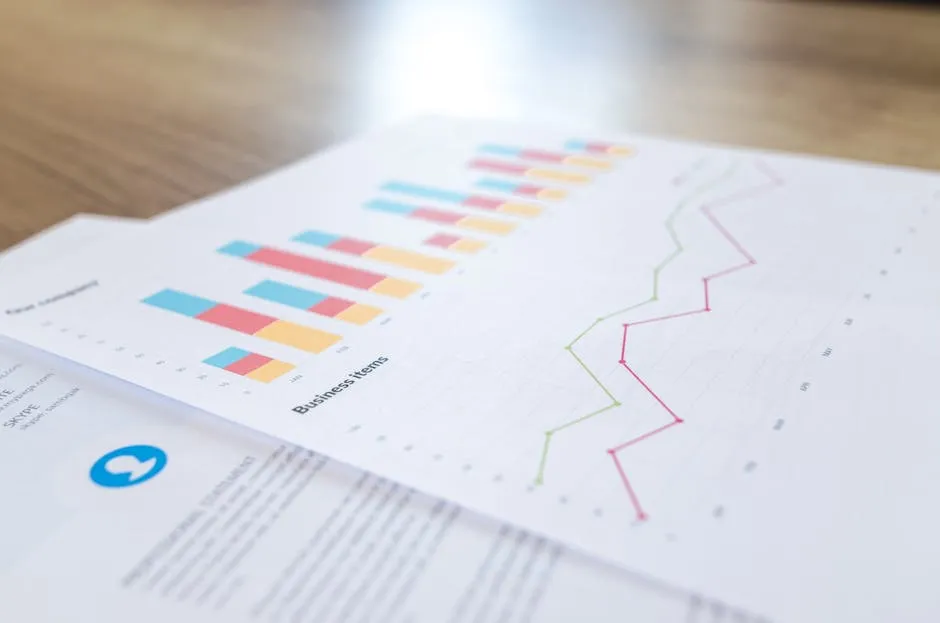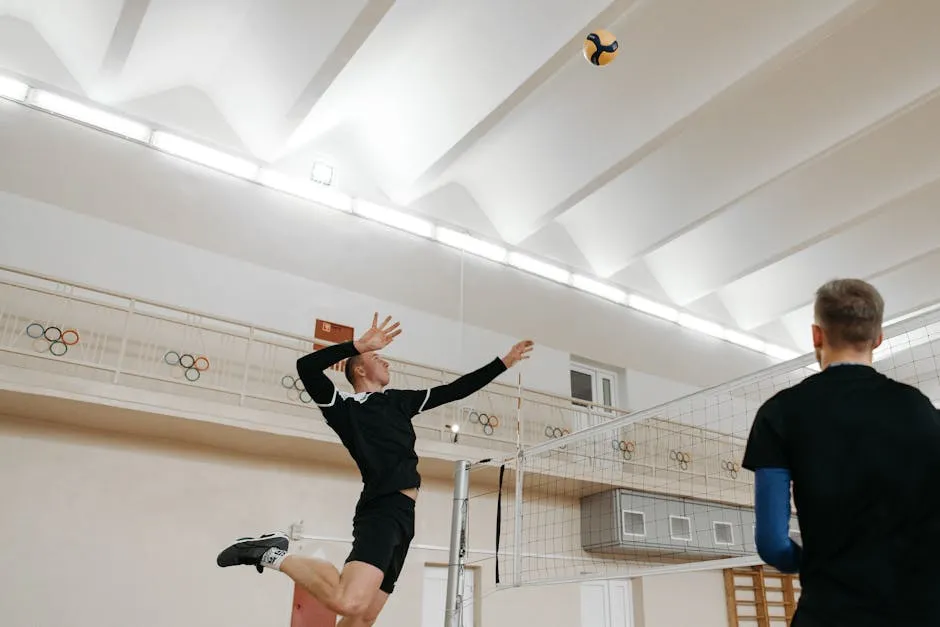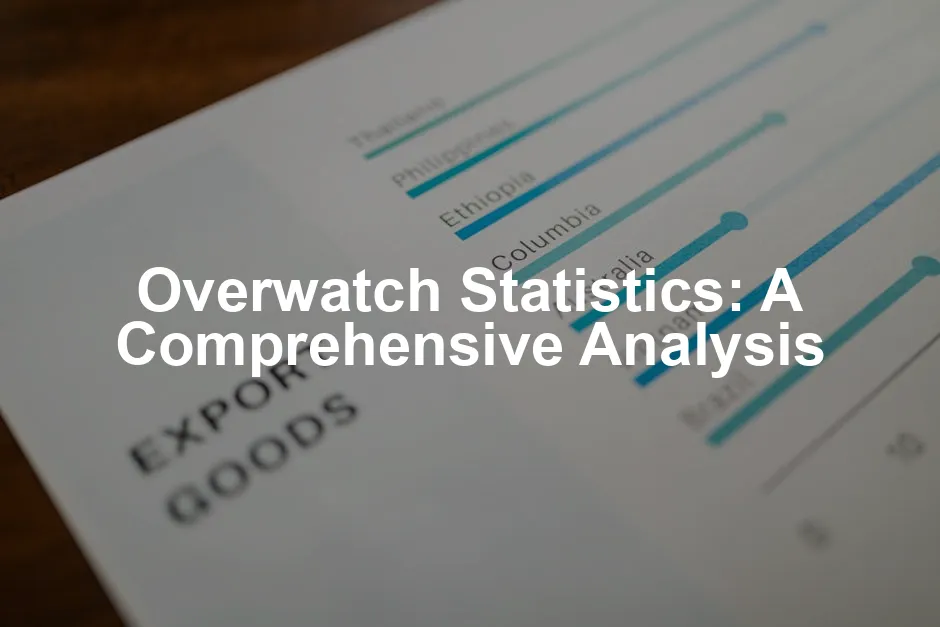Introduction
Overwatch is not just a game; it’s a phenomenon. Since its launch in 2016, the Overwatch community has exploded, creating a rich environment filled with strategies, rivalries, and, of course, statistics. Statistics play a crucial role in understanding player performance, hero effectiveness, and overall game dynamics. They provide players with the data they need to refine their strategies and elevate their gaming experience.
Why should you care about statistics? Well, think of them as your trusty sidekick. They help you identify your strengths and weaknesses while shedding light on the meta trends. By analyzing these numbers, players can adjust their gameplay tactics, pick the right heroes, and ultimately, contribute to their team’s success.
The interest in Overwatch statistics has surged over the years. Websites like Overbuff and OP.GG provide detailed insights into player performance, hero usage, and match outcomes. The community is eager to dissect every number, from KDA ratios to win rates, making the game even more engaging. As we dive deeper into this analysis, we’ll uncover the significance of these statistics and how they can transform your Overwatch experience.
If you’re looking to dive into the Overwatch universe, you can start with the Overwatch Game for PC. It’s a fantastic way to experience the thrill and strategy of this beloved game!
The Importance of Overwatch Statistics
Understanding Player Performance
When it comes to measuring player performance, statistics are your best friend. Metrics like KDA (Kill/Death/Assist) are vital. They reveal how effectively players are contributing to their team’s success. A high KDA indicates a player is not just surviving but thriving. It’s like being the superhero of your gaming squad—saving the day and looking good while doing it!
By tracking these numbers, players can identify patterns in their gameplay. Maybe you’re great at getting kills but need to work on assists. Or perhaps your deaths are piling up faster than your kills. Statistics highlight these areas, allowing players to focus on improving their weaknesses.

To enhance your gaming setup, consider investing in a Gaming Mouse like the Logitech G502. Its precision and customizable features can significantly boost your performance!
Hero Selection and Win Rates
When it comes to selecting heroes, statistics are invaluable. Every hero has a pick rate and a win rate that can guide your choices. For instance, if Cassidy has a pick rate of 4.36% with a win rate of 47.27%, you might want to consider other options if you’re looking for a higher chance of victory.
The numbers tell a story. They reveal which heroes are performing well in the current meta and which ones might need a little love from the developers. By leveraging this data, players can make informed decisions about their hero selection, leading to better performances and more enjoyable matches.

And if you’re a fan of the lore, grab a copy of Overwatch: The Art of Overwatch. It’s a fantastic way to dive deeper into the game’s universe!
Competitive Play Insights
In the competitive scene, statistics take center stage. Professional teams analyze hero compositions and player performance metrics to create winning strategies. They study statistics to adapt to shifts in the meta, ensuring they always have the upper hand.
Imagine being a coach, armed with data that shows which heroes dominate in specific maps. This insight can make all the difference between victory and defeat. By embracing statistics, players can elevate their gameplay to a competitive level, allowing for a deeper understanding of team dynamics and strategies.
For those looking to stream their gameplay, a quality Capture Card like the Elgato HD60 S can help you showcase your skills to the world!
In summary, the importance of Overwatch statistics cannot be overstated. They provide insights into player performance, guide hero selection, and inform competitive strategies. With a growing community obsessed with these numbers, understanding and utilizing statistics can significantly enhance your Overwatch experience. Whether you’re a casual player looking to improve or a competitive gamer aiming for glory, the data is there to help you succeed.
Overview of Key Statistics in Overwatch
When it comes to Overwatch, statistics are like the secret sauce that enhances the game experience. They help players make informed decisions, from hero selection to gameplay strategies. Let’s break down some of the most important statistics that shape the current Overwatch scene.

Top Heroes by Pick Rate and Win Rate
The heroes you select can make or break your match. Here’s a summary of the top heroes, their pick rates, and win rates based on the latest data from Overbuff. This table reveals which heroes are currently hot and which ones might need a little more love.
| Hero | Pick Rate | Win Rate |
|---|---|---|
| Cassidy | 4.36% | 47.27% |
| Ana | 7.55% | 49.12% |
| Mercy | 5.50% | 50.47% |
| Reinhardt | 3.27% | 53.79% |
| D.Va | 3.03% | 51.90% |
| Genji | 3.76% | 50.68% |
| Widowmaker | 3.32% | 47.79% |
| Kiriko | 4.19% | 48.24% |
From this data, Ana stands tall as the most played support hero, while Cassidy is leading among damage heroes. The numbers show that Mercy is also performing well, with a decent win rate. It’s clear that understanding these statistics can guide players in choosing heroes that fit their playstyle and the current meta.

Role Distribution
Now, let’s take a peek at how different roles stack up in Overwatch. The distribution of heroes across three main roles—Tank, Damage, and Support—plays a significant role in team composition and effectiveness.
- Tank: Tanks are the frontline guardians. Currently, Reinhardt and D.Va lead in usage, showcasing their ability to absorb damage and control space. Their higher win rates indicate that a solid tank can significantly contribute to team success.
- Damage: The damage role is all about eliminating enemies and creating space for your team. Cassidy and Genji are popular choices, with Genji’s versatility making him a favorite. The lower win rate for Cassidy suggests he might be more situational or requires a specific strategy to excel.
- Support: Supports keep teammates alive and enhance their performance. Ana and Mercy are at the forefront, with Mercy’s healing output proving vital to team survival. The high pick rate of Ana suggests that players value her utility in both healing and damage.
By analyzing these roles, players can identify which heroes are trending and how to balance their team compositions. A well-rounded team with a mix of these roles can lead to more victories.

To complement your gameplay, consider lighting up your gaming space with RGB LED Strip Lights. They can add that extra flair to your setup!
Performance Metrics
Performance metrics such as KDA (Kill/Death/Assist) hold the key to understanding hero effectiveness. They provide insights into how well a hero performs in matches. For example, a hero with a high KDA indicates a player is contributing significantly to their team’s efforts, while a low KDA may suggest room for improvement.
| Hero | KDA |
|---|---|
| Ana | 4.45 |
| Mercy | 4.12 |
| D.Va | 7.04 |
| Reinhardt | 3.11 |
| Cassidy | 2.64 |
These metrics are crucial for assessing hero performance. Players can focus on heroes with favorable KDA ratios to maximize their impact in matches. The statistics reveal that D.Va leads the pack, showing her potential for high involvement in eliminations while maintaining survivability.
In summary, key statistics in Overwatch not only guide hero selection but also illuminate player performance across different roles. By keeping an eye on pick rates, win rates, and performance metrics, players can refine their strategies and improve their overall gameplay experience. Whether you’re a casual gamer or a competitive player, understanding these numbers is essential for climbing the ranks in Overwatch.

Competitive Overwatch Statistics
Prize Pool Trends and Earnings
When it comes to competitive Overwatch, the prize pools tell an exciting story. Over the years, we’ve seen considerable growth in prize money, showcasing the game’s increasing popularity. Let’s take a look at the prize pools from significant tournaments since the game’s inception:
| Year | Total Prize Money |
|---|---|
| 2015 | $3,320 |
| 2016 | $2,225,308 |
| 2017 | $3,687,968 |
| 2018 | $6,955,620 |
| 2019 | $9,747,516 |
| 2020 | $8,037,066 |
| 2021 | $6,204,908 |
| 2022 | $6,700,833 |
| 2023 | $5,289,941 |
| 2024 | $3,127,594 |
| Total | $51,704,305 |
From 2015 to 2023, we witnessed a rollercoaster of prize money. The peak came in 2019 with an impressive $9.7 million. However, 2023 saw a dip, reflecting changes in tournament structures. This fluctuation can be linked to varying player interest, sponsorships, and the competitive landscape. Each year, the stakes rise, and teams fight tirelessly for a piece of this lucrative pie.

Player Performance in Tournaments
Now, let’s shine a spotlight on the stars of the competitive scene. Players like “Fleta” and “Jjonak” have made headlines with their outstanding performances in tournaments. According to data from Liquipedia, these players have not just racked up kills but have also contributed significantly to their teams’ successes.
For instance, Fleta, renowned for his flexibility, has dominated multiple tournaments, showcasing a mastery of various heroes. Jjonak, on the other hand, has set the bar high for supports, consistently delivering exceptional healing and damage output. These players exemplify the talent in the Overwatch League (OWL), where skill and teamwork reign supreme.
This competitive environment has produced teams like the San Francisco Shock and the Shanghai Dragons, who have consistently performed at the top level. Their synergy and strategic gameplay have captivated audiences, making them household names. With each tournament, the competition intensifies, and players rise to the occasion, eager to leave their mark.

Analysis of Tournament Formats and Their Impact
Tournament formats play a crucial role in shaping team performance and viewer engagement. Traditionally, Overwatch tournaments have followed a single-elimination format, where one loss can end a team’s journey. This format increases the drama but can also create unexpected outcomes.
For instance, in the 2021 OWL playoffs, teams had to adapt quickly to survive. The tournament shifted to a double-elimination format, allowing teams a second chance. This change not only kept viewers on the edge of their seats but also provided teams with opportunities to adjust their strategies mid-tournament.
Additionally, the introduction of regional leagues has made tournaments more accessible. Fans can cheer for their local teams, fostering a deeper connection to the game. This sense of community enhances viewer engagement, as people rally behind their favorites.
In conclusion, competitive Overwatch statistics reveal a thrilling landscape. Prize pools continue to grow, and players shine in tournaments, showcasing their skills and strategies. Tournament formats significantly influence outcomes and viewer interest, highlighting the dynamic nature of the Overwatch competitive scene. As we look to the future, one thing is clear: the excitement will only continue to rise.
Streaming and Community Engagement Statistics
Twitch Viewership Data
Overwatch has become a streaming sensation, and Twitch is the epicenter of this phenomenon. The statistics are astounding! During significant events, Overwatch attracts massive audiences. For instance, the peak viewership hit a staggering 634,296 on October 8, 2022. That’s not just a crowd; it’s a small city tuning in to watch their favorite heroes battle it out!
But what about the average viewers? On average, Overwatch garners around 32,046 viewers. That’s like filling a medium-sized stadium with fans, all eager to see the latest plays and strategies unfold. The number of live channels also reflects this popularity. With approximately 1,586 average channels broadcasting Overwatch content, it’s evident that the community is thriving.
Interestingly, weekends boost viewership even more. Overwatch is streamed by 8% more channels and watched by 20% more viewers on weekends compared to weekdays. Who doesn’t love a good gaming binge on Saturday and Sunday?
These numbers speak volumes about Overwatch’s appeal. The game isn’t just played; it’s celebrated. The Twitch community is actively engaged, discussing strategies, sharing memes, and reacting to intense moments in real-time.

Community Reactions and Popularity
Community feedback on Overwatch statistics is also vibrant and varied. Platforms like Reddit are buzzing with discussions about hero stats, player performances, and gameplay experiences. For example, one user exclaimed how unsurprising it is that Ana remains the most played hero. This sentiment echoes across numerous threads, highlighting players’ love for certain characters and their abilities.
Users frequently share their thoughts on hero balance and performance metrics, contributing to a lively discourse. Some even express surprise at Mercy’s popularity, suggesting that the meta might be shifting. These discussions not only reflect player sentiment but also foster a sense of community.
Moreover, the humor in these conversations adds a layer of enjoyment. Players banter about game mechanics, often poking fun at the absurdity of certain stats. One user once quipped about a seemingly impossible battle pass tier, leading to a cascade of funny comments and engagement.
This community interaction is vital. It shows how invested players are, not just in the game but in each other. The sharing of experiences, tips, and light-hearted jokes keeps the Overwatch spirit alive.
In conclusion, Twitch viewership data and community feedback indicate a thriving, engaged audience surrounding Overwatch. The statistics not only highlight the game’s popularity but also foster a sense of camaraderie among players. As they rally around their favorite heroes and hilarious moments, the Overwatch community continues to grow, making the game more than just a pastime—it’s a shared experience.

Future of Overwatch Statistics
Anticipated Changes and Features
The future of Overwatch statistics looks bright, with exciting changes on the horizon. Players are eagerly anticipating more detailed analytics to enhance their gaming experience. Imagine having access to in-depth statistics that break down your performance by hero, map, and even specific abilities!
Developers are likely to introduce features that allow players to track their progress over time. This could include personalized dashboards showcasing key metrics like KDA, win rates, and even the impact of specific plays. Such tools would empower players to refine their strategies and focus on areas needing improvement.
Improved matchmaking based on statistical analysis could also be on the way. Players crave balanced matches that pit them against opponents of similar skill levels. Enhanced algorithms could analyze player stats in real-time, ensuring fairer matchmaking experiences. Who wouldn’t want to face off against opponents who make for a more thrilling challenge?
Moreover, the integration of community feedback into statistical tracking will likely grow. Developers can use insights from platforms like Reddit to understand player sentiment and preferences. This symbiotic relationship between players and developers could lead to a more tailored gaming experience, where statistics not only inform but also enhance gameplay.

Community and Developer Interaction
The interaction between the community and developers is vital for the evolution of Overwatch statistics. Players are passionate about the game, and their voices should be heard. Developer Q&As, community surveys, and forums could become more frequent, allowing players to express their wishes for future features directly.
With the rise of social media, players can voice their opinions and share their ideas with a broader audience. This interaction fosters a sense of ownership among players, making them feel like active participants in the game’s growth. A community-driven approach to developing new features can lead to innovations that resonate with players, ultimately enhancing their experience.
In summary, the future of Overwatch statistics is poised for exciting advancements. Players can look forward to more detailed analytics, improved matchmaking, and a stronger connection with developers. As the community and developers work hand-in-hand, the evolution of Overwatch will lead to a richer gaming experience for all. The best is yet to come!

Community and Developer Interaction
The interaction between the Overwatch community and its developers is key to improving statistics and gameplay mechanics. Players are not just passive participants; they are active contributors. Their feedback helps shape the game, making it more engaging and dynamic.
Developers often monitor community forums, social media, and platforms like Reddit to catch the pulse of player sentiment. When a hero seems overpowered or underwhelming, players voice their concerns. This dialogue leads to adjustments that enhance balance and gameplay. It’s like a game of telephone, where each player’s voice can impact the final message.
A prime example is the frequent hero reworks. Developers listen to community feedback about which heroes need buffs or nerfs. This interaction fosters a collaborative environment. It’s reassuring for players to know their opinions matter. It creates a sense of ownership and investment in the game.
Moreover, community-driven initiatives like tournaments and events also influence statistics. Players analyze these events and share insights on hero performances and strategies. This data helps shape future patches and hero updates. Developers can observe which heroes dominate in competitive play and adjust accordingly.
In essence, the relationship between community input and developer response is vital. It ensures Overwatch remains fresh and relevant. Players feel valued, and developers can create a more balanced game experience. Together, they form a feedback loop that continuously improves the game.
Conclusion
Overwatch statistics are more than just numbers; they are the backbone of gameplay and strategy. They provide crucial insights into player performance, hero effectiveness, and even the evolving meta. Understanding these statistics can significantly enhance your Overwatch experience.
Statistics shed light on your strengths and weaknesses. Are you a damage-dealing machine, or do you need to work on your support skills? With metrics like KDA, win rates, and pick rates at your fingertips, players can make informed decisions about their gameplay. This knowledge can mean the difference between a glorious victory and a humbling defeat.
Additionally, statistics play a vital role in competitive play. Teams analyze performance data to refine their strategies and compositions. They adjust their hero picks based on current trends, ensuring they stay ahead of the curve. For aspiring professional players, mastering statistics is essential for success.
As you embark on your Overwatch journey, remember to embrace the power of statistics. Websites like Overbuff and Liquipedia offer valuable insights into player performances and trends. Use these resources to track your progress and understand the game better. For a comprehensive understanding of statistical metrics, check out this AP statistics formula sheet.
For those looking to deepen their understanding of statistics in gaming, the AP statistics formula sheet can be an invaluable resource.
In conclusion, Overwatch statistics are an essential tool for any player. They enhance gameplay, inform strategies, and foster a deeper understanding of the game. So, dive into the numbers, refine your skills, and watch as you climb the ranks!
And while you’re at it, don’t forget to check out some awesome Overwatch League Official Merchandise to show off your fandom!
What are the most common statistics used in Overwatch?
Overwatch statistics are critical for understanding gameplay dynamics. Common metrics include pick rates, win rates, and KDA (Kill/Death/Assist). Pick rates indicate how often a hero is chosen, while win rates show their effectiveness in matches. KDA provides insights into a player’s contribution to the team. Tracking these statistics can help players make informed choices about hero selection and gameplay strategies.
How can I access Overwatch statistics?
Accessing Overwatch statistics is easy and straightforward. Popular platforms like Overbuff and OP.GG provide in-depth analysis of player performance, hero usage, and match outcomes. Simply visit these websites, and you can explore detailed statistics tailored to your needs. Whether you’re looking for personal stats or broader trends, these resources have you covered.
Why are statistics important for competitive play?
Statistics are crucial in competitive Overwatch. They inform decision-making and strategy formulation. Teams analyze performance metrics to refine their compositions and tactics. Understanding the current meta through statistics allows teams to make informed hero selections. In competitive gaming, knowledge is power. The right statistics can lead to victory and elevate a team’s performance. Embracing data helps players stay ahead of the competition.
Please let us know what you think about our content by leaving a comment down below!
Thank you for reading till here 🙂
All images from Pexels




